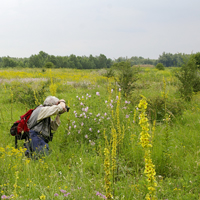Description
The hummingbird hawk-moth (Macroglossum stellatarum) is a species of hawk moth found across temperate regions of Eurasia. The species is named for its similarity to hummingbirds, as they feed on the nectar of tube-shaped flowers using their long proboscis while hovering in the air; this resemblance is an example of convergent evolution. Life cycle: Two or more broods are produced each year. The adult may be encountered at any time of the year, especially in the south of the range, where there may be three or four broods. It overwinters as an adult in a crevice among rocks, trees, and buildings. On very warm days it may emerge to feed in mid-winter. Unlike other moths, they have no sexual dimorphism in the size of their antennal lobes. Habitat and host plants: Hummingbird hawk-moths can be easily seen in gardens, parks, meadows, bushes, and woodland edge, where the preferred food plants grow (honeysuckle, red valerian and many others). Their larvae usually feed on bedstraws or madders (Rubia) but have been recorded on other Rubiaceae and Centranthus, Stellaria, and Epilobium. Adults are particularly fond of nectar-rich flowers with a long and narrow calyx, since they can then take advantage of their long proboscis and avoid competition from other insects. Flowers with longer tubes typically present the feeding animal a higher nectar reward. Proboscis length is thought to have been evolutionarily impacted by the length of flower feeding tubes.] Examples of such plants include Centranthus, Jasminum, Buddleia, Nicotiana, Primula, Viola, Syringa, Verbena, Echium, Phlox, and Stachys. Distribution: The hummingbird hawk-moth is distributed throughout the northern Old World from Portugal to Japan, but it breeds mainly in warmer climates (southern Europe, North Africa, and points east). Three generations are produced in a year in Spain. This Picture is made during a Vacation in Bulgaria in May 2018.

![Hummingbird hawk moth (Macroglossum stellatarum) in Flight The hummingbird hawk-moth (Macroglossum stellatarum) is a species of hawk moth found across temperate regions of Eurasia. The species is named for its similarity to hummingbirds, as they feed on the nectar of tube-shaped flowers using their long proboscis while hovering in the air; this resemblance is an example of convergent evolution.
Life cycle:
Two or more broods are produced each year. The adult may be encountered at any time of the year, especially in the south of the range, where there may be three or four broods. It overwinters as an adult in a crevice among rocks, trees, and buildings. On very warm days it may emerge to feed in mid-winter. Unlike other moths, they have no sexual dimorphism in the size of their antennal lobes.
Habitat and host plants:
Hummingbird hawk-moths can be easily seen in gardens, parks, meadows, bushes, and woodland edge, where the preferred food plants grow (honeysuckle, red valerian and many others).
Their larvae usually feed on bedstraws or madders (Rubia) but have been recorded on other Rubiaceae and Centranthus, Stellaria, and Epilobium.
Adults are particularly fond of nectar-rich flowers with a long and narrow calyx, since they can then take advantage of their long proboscis and avoid competition from other insects. Flowers with longer tubes typically present the feeding animal a higher nectar reward. Proboscis length is thought to have been evolutionarily impacted by the length of flower feeding tubes.] Examples of such plants include Centranthus, Jasminum, Buddleia, Nicotiana, Primula, Viola, Syringa, Verbena, Echium, Phlox, and Stachys.
Distribution:
The hummingbird hawk-moth is distributed throughout the northern Old World from Portugal to Japan, but it breeds mainly in warmer climates (southern Europe, North Africa, and points east). Three generations are produced in a year in Spain.
This Picture is made during a Vacation in Bulgaria in May 2018. Black Color Stock Photo Hummingbird hawk moth (Macroglossum stellatarum) in Flight The hummingbird hawk-moth (Macroglossum stellatarum) is a species of hawk moth found across temperate regions of Eurasia. The species is named for its similarity to hummingbirds, as they feed on the nectar of tube-shaped flowers using their long proboscis while hovering in the air; this resemblance is an example of convergent evolution.
Life cycle:
Two or more broods are produced each year. The adult may be encountered at any time of the year, especially in the south of the range, where there may be three or four broods. It overwinters as an adult in a crevice among rocks, trees, and buildings. On very warm days it may emerge to feed in mid-winter. Unlike other moths, they have no sexual dimorphism in the size of their antennal lobes.
Habitat and host plants:
Hummingbird hawk-moths can be easily seen in gardens, parks, meadows, bushes, and woodland edge, where the preferred food plants grow (honeysuckle, red valerian and many others).
Their larvae usually feed on bedstraws or madders (Rubia) but have been recorded on other Rubiaceae and Centranthus, Stellaria, and Epilobium.
Adults are particularly fond of nectar-rich flowers with a long and narrow calyx, since they can then take advantage of their long proboscis and avoid competition from other insects. Flowers with longer tubes typically present the feeding animal a higher nectar reward. Proboscis length is thought to have been evolutionarily impacted by the length of flower feeding tubes.] Examples of such plants include Centranthus, Jasminum, Buddleia, Nicotiana, Primula, Viola, Syringa, Verbena, Echium, Phlox, and Stachys.
Distribution:
The hummingbird hawk-moth is distributed throughout the northern Old World from Portugal to Japan, but it breeds mainly in warmer climates (southern Europe, North Africa, and points east). Three generations are produced in a year in Spain.
This Picture is made during a Vacation in Bulgaria in May 2018. Black Color Stock Photo](https://media.istockphoto.com/id/1474819779/photo/hummingbird-hawk-moth-in-flight.jpg?s=1024x1024&w=is&k=20&c=b3mg-5FZf_y-5A4J0Nf4SQ4Znq9hJLTnSNCmdLrA8HI=)
